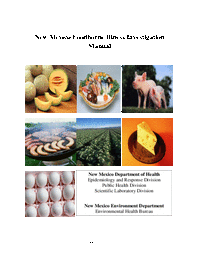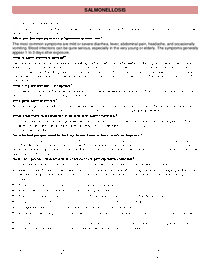Help
 Foodborne Illness Manual for Investigation
Foodborne Disease Agents - Help
March 1, 2016
Foodborne Illness Manual for Investigation
Foodborne Disease Agents - Help
March 1, 2016
This purpose of this manual is to provide guidance for prompt detection of and response to foodborne illness outbreaks in New Mexico, recognizing that a successful foodborne illness outbreak investigation requires collaboration between partners from the disciplines of epidemiology, environmental health, food science and microbiology.
 Hepatitis A Fact Sheet
Foodborne Disease Agents - Help
March 1, 2016
Hepatitis A Fact Sheet
Foodborne Disease Agents - Help
March 1, 2016
Hepatitis A is a liver disease caused by the hepatitis A virus. Symptoms may include tiredness, poor appetite, fever and nausea. Urine may become darker in color. A person may develop jaundice which is a yellowing of the skin and the whites of the eyes. The symptoms may appear 2 to 6 weeks after exposure, but usually within four weeks.
 Botulism Fact Sheet
Foodborne Disease Agents - Help
March 1, 2016
Botulism Fact Sheet
Foodborne Disease Agents - Help
March 1, 2016
Botulism is a neuroparalytic disorder characterized by an acute, afebrile, symmetric descending flaccid paralysis. Although rare, botulism is a serious illness caused by a nerve toxin produced by the bacterium Clostridium botulinum.
 Campylobacteriosis Fact Sheet
Foodborne Disease Agents - Help
March 1, 2016
Campylobacteriosis Fact Sheet
Foodborne Disease Agents - Help
March 1, 2016
Campylobacter infection causes acute gastroenteritis. Most infections are acquired by ingestion of undercooked chicken or pork or unpasteurized milk, from handling raw poultry, or from direct contact with fecal material of infected pets or farm animals.
 Cryptosporidiosis Fact Sheet
Foodborne Disease Agents - Help
March 1, 2016
Cryptosporidiosis Fact Sheet
Foodborne Disease Agents - Help
March 1, 2016
Cryptosporidium species are protozoa that can cause diarrheal illness in humans. The protozoa have been found in a variety of hosts such as mammals, birds, and reptiles. Outbreaks have been associated with contamination of municipal water supplies and swimming pools, as well as petting zoos.
 Escherichia coli Fact Sheet
Foodborne Disease Agents - Help
March 1, 2016
Escherichia coli Fact Sheet
Foodborne Disease Agents - Help
March 1, 2016
Shiga toxin-producing E. coli (STEC) are diarrhea-causing strains of a group of bacteria called Escherichia coli. E. coli O157:H7 is the most well-known type of STEC, but there are many other types that can cause illness in humans. While STEC infection has traditionally been associated with animal products, outbreaks associated with produce have become more common.
 Giardiasis Fact Sheet
Foodborne Disease Agents - Help
March 1, 2016
Giardiasis Fact Sheet
Foodborne Disease Agents - Help
March 1, 2016
Giardiasis is a parasitic intestinal disease that may result in asymptomatic infection; acute, self-limited diarrhea; or chronic intermittent symptoms. The disease is spread primarily from person to person through ingestion of infective cysts.
 Listeriosis Fact Sheet
Foodborne Disease Agents - Help
March 1, 2016
Listeriosis Fact Sheet
Foodborne Disease Agents - Help
March 1, 2016
Listeriosis is caused by the bacterium Listeria monocytogenes. Infection results from ingestion of contaminated foods or from maternal transmission to the neonate. In high-risk individuals, listeriosis causes meningoencephalitis and/or septicemia.
 Salmonellosis Fact Sheet
Foodborne Disease Agents - Help
March 1, 2016
Salmonellosis Fact Sheet
Foodborne Disease Agents - Help
March 1, 2016
Salmonella infection most commonly causes acute gastroenteritis. Most infections are acquired by ingestion of contaminated food or water (particularly raw eggs or milk), or by cross contamination during food handling (particularly raw poultry). Laboratory diagnosis is made by stool culture.
 Shigellosis Fact Sheet
Foodborne Disease Agents - Help
March 1, 2016
Shigellosis Fact Sheet
Foodborne Disease Agents - Help
March 1, 2016
Shigellosis most commonly causes acute gastroenteritis. Illness is often characterized by diarrhea, fever, nausea, and sometimes vomiting and cramps; mild infections can occur. Stools often contain blood and mucus. Most infections are acquired by fecal-oral transmission from an infected person, or from fecal contamination of water or food.


